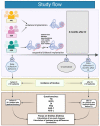Effects of auditory rehabilitation with cochlear implant on tinnitus prevalence and distress, health-related quality of life, subjective hearing and psychological comorbidities: Comparative analysis of patients with asymmetric hearing loss (AHL), double-sided (bilateral) deafness (DSD), and single-sided (unilateral) deafness (SSD)
- PMID: 36712436
- PMCID: PMC9877424
- DOI: 10.3389/fneur.2022.1089610
Effects of auditory rehabilitation with cochlear implant on tinnitus prevalence and distress, health-related quality of life, subjective hearing and psychological comorbidities: Comparative analysis of patients with asymmetric hearing loss (AHL), double-sided (bilateral) deafness (DSD), and single-sided (unilateral) deafness (SSD)
Abstract
Introduction: Auditory rehabilitation with a cochlear implant (CI), in many cases, positively impacts tinnitus. However, it is unclear if the tinnitus-related benefit of CI is equal for patients with various indications for CI. Therefore, this study aimed to determine differences in tinnitus prevalence and distress, health-related quality of life, subjective hearing, perceived stress, and psychological comorbidities between patients diagnosed with asymmetric hearing loss (AHL), single-sided (unilateral) deafness (SSD), and double-sided (bilateral) deafness (DSD) before and six months after cochlear implantation.
Methods: One hundred-one CI candidates were included in this prospective study (39 AHL patients, 23 DSD patients, and 39 SSD patients). The patients completed questionnaires measuring tinnitus distress, health-related quality of life, subjective hearing, perceived stress, and psychological comorbidities before and 6 months after CI.
Results: The prevalence of tinnitus in the entire cohort (80.2% before CI) decreased 6 months after CI to 71.3%. The DSD group had the lowest tinnitus prevalence at both time points. The degree of tinnitus-induced distress decreased significantly in all three groups after CI. Differences in quality of life, subjective hearing, and psychological comorbidities between the groups at the study onset disappeared after CI. Significant correlations existed between anxiety, depression, and tinnitus distress in AHL and SSD but not in DSD patients before and after CI.
Discussion: Our results demonstrate significant differences between the three groups of CI candidates, which might affect the implantation outcome. These differences suggest a need for personalized psychological counseling during the auditory rehabilitation process, focusing on anxiety and depressive symptoms for SSD and AHL patients.
Keywords: asymmetric hearing loss; auditory rehabilitation; cochlear implant; double-sided deafness; single-sided deafness; tinnitus.
Copyright © 2023 Olze, Ketterer, Péus, Häußler, Hildebrandt, Gräbel and Szczepek.
Conflict of interest statement
The authors declare that the research was conducted in the absence of any commercial or financial relationships that could be construed as a potential conflict of interest.
Figures






Similar articles
-
[Cochlear implant and tinnitus].HNO. 2023 Nov;71(11):693-701. doi: 10.1007/s00106-023-01376-w. Epub 2023 Oct 10. HNO. 2023. PMID: 37815555 Review. German.
-
[Prospective comparative analysis of cochlear implant patients with single-sided deafness and asymmetric hearing loss with regard to health-related quality of life, tinnitus distress and psychological comorbidities].HNO. 2023 Aug;71(8):494-503. doi: 10.1007/s00106-023-01318-6. Epub 2023 Jul 12. HNO. 2023. PMID: 37436479 Free PMC article. German.
-
Cochlear Implantation and Other Treatments in Single-Sided Deafness and Asymmetric Hearing Loss: Results of a National Multicenter Study Including a Randomized Controlled Trial.Audiol Neurootol. 2021;26(6):414-424. doi: 10.1159/000514085. Epub 2021 Mar 31. Audiol Neurootol. 2021. PMID: 33789270 Free PMC article. Clinical Trial.
-
(Even Off-Label) Cochlear Implantation in Single-Sided Deafness and Asymmetric Hearing Loss Results in Measurable Objective and Subjective Benefit.Otol Neurotol. 2022 Sep 1;43(8):e895-e902. doi: 10.1097/MAO.0000000000003623. Otol Neurotol. 2022. PMID: 35970168
-
The case for cochlear implantation in unilateral and asymmetric sensorineural hearing loss.Curr Opin Otolaryngol Head Neck Surg. 2020 Oct;28(5):329-334. doi: 10.1097/MOO.0000000000000656. Curr Opin Otolaryngol Head Neck Surg. 2020. PMID: 32841959 Review.
Cited by
-
[Cochlear implant and tinnitus].HNO. 2023 Nov;71(11):693-701. doi: 10.1007/s00106-023-01376-w. Epub 2023 Oct 10. HNO. 2023. PMID: 37815555 Review. German.
-
Are tinnitus burden and tinnitus exacerbation after cochlear implantation influenced by insertion technique, array dislocation, and intracochlear trauma?Front Neurol. 2024 Oct 30;15:1477259. doi: 10.3389/fneur.2024.1477259. eCollection 2024. Front Neurol. 2024. PMID: 39539659 Free PMC article.
-
Electrical Ear Canal Stimulation as a Therapeutic Approach for Tinnitus-A Proof of Concept Study.J Clin Med. 2024 May 1;13(9):2663. doi: 10.3390/jcm13092663. J Clin Med. 2024. PMID: 38731192 Free PMC article.
-
A cross-sectional study of how high-frequency hearing loss impacts cognitive functions in middle-aged-to-older adults.Front Aging Neurosci. 2025 Apr 28;17:1560307. doi: 10.3389/fnagi.2025.1560307. eCollection 2025. Front Aging Neurosci. 2025. PMID: 40357231 Free PMC article.
-
Clinical characteristics and prognosis of sudden sensorineural hearing loss in single-sided deafness patients.Front Neurol. 2023 Sep 27;14:1230340. doi: 10.3389/fneur.2023.1230340. eCollection 2023. Front Neurol. 2023. PMID: 37830094 Free PMC article.
References
LinkOut - more resources
Full Text Sources

